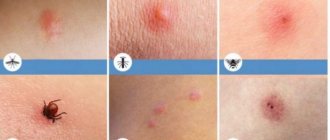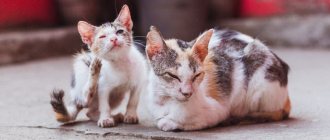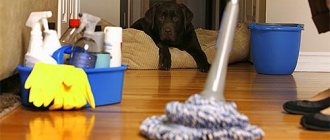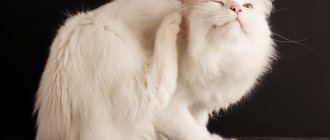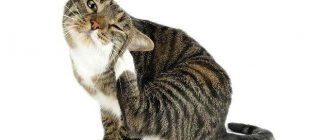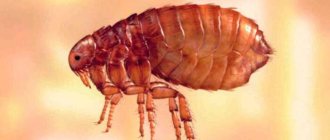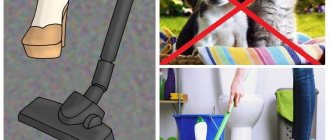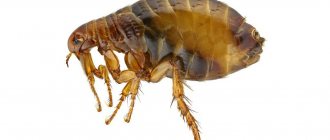The presence of fleas in a cat is not only an unnerving scratching of the pet for the owner, but a possible cause of a serious illness for the animal. Scratching from insect bites can lead to infection of the wounds with pathogenic microflora. In addition, the cat may experience an allergic reaction, accompanied by severe itching, swelling and fever.
Brief information: a flea is a wingless insect that parasitizes warm-blooded animals. The size of the insect is about 3 mm. The flea feeds on the blood of its owner, which it obtains by piercing the skin. It is a carrier of various infections.
Symptoms of infection
Fleas in cats cause characteristic symptoms that are simply impossible not to notice:
- frequent scratching, or more intense than usual licking of the fur;
- restless sleep;
- nervous behavior;
- loss of appetite.
In addition, on the undercoat of the animal you can see traces of insect activity - excrement resembling black grains of sand, and on the skin - scratches, wounds and scabs.
If the disease is not treated, it can lead to the following consequences:
- exhaustion of the animal from lack of sleep and nervous excitement;
- the appearance of bald spots on wool;
- development of anemia (decrease in hemoglobin level). Outwardly, this is manifested by the animal’s lethargy, weight loss, and pale gums. This condition requires treatment by a veterinarian;
- helminth infection;
- allergic dermatitis. This disease is characterized by the appearance of red spots on the skin of the cat's body, against which small blisters then appear. Subsequently, the bubbles burst (on their own or from scratching), and in their place weeping areas form. Over time, they dry out, scar, and scales and crusts form;
- secondary infection of wounds from scratching and, as a result, to inflammation, abscess and even sepsis.
A cat can get fleas even if it does not go outside on its own. Fleas can get on an animal when traveling on public transport, while participating in exhibitions and competitions. After visiting such places, you should examine your cat to prevent the breeding of “uninvited guests.”
Also, a likely source of fleas getting into the apartment and, accordingly, onto the cat is the owner of the animal himself. A flea can jump on a person’s shoes or clothes on the street or in a hallway, and thus get home.
If there are few fleas on a cat, then they may not be visible visually. You can check for the presence of parasites as follows:
- place the animal on a piece of white cloth (fleas, their excrement or eggs will be clearly visible on it);
- Take a special flea comb (with fine teeth) and gently comb the animal's fur from head to tail. Fleas and their metabolic products will either get stuck in the teeth of the comb or fall out onto the bedding fabric;
- You can distinguish dirt from excrement by placing unidentified black particles on a wet cloth. The excrement will change its color from black to brown or red as it contains the animal's blood.
What to do if you find a flea?
First of all, there is no need to panic. Parasitic insects are living organisms, which means they can be destroyed. For this purpose, special flea remedies for cats have been developed, which have been tested and successfully used in practice by millions of cat owners.
A brief algorithm of actions if you find parasites on your pet or in your apartment (house):
- if there are few fleas, or your kitten is still very small, then wash the animal with a special shampoo;
- If there are a large number of fleas, the shampoo may not be effective. In this situation, special drops should be used that will either kill the insects or make their offspring unviable. Read more about how to get rid of fleas from a cat in the next section of this article;
- After antiparasitic treatment, it is necessary to disinfest the room(s) where the cat lives. You can learn how to do this in the last section of this article;
- the next step is to eliminate the damage to the animal’s health caused by fleas. You can relieve your cat from itching and speed up the healing of wounds with the help of Miramistin solution. This pharmaceutical product disinfects wounds and has an anti-inflammatory effect; it can be purchased at a regular pharmacy. If you contact your veterinarian, he will prescribe an antihistamine. A visit to the doctor is also necessary if the wounds begin to rot.
Flea drops
Parasite drops are the most effective remedy for ridding a cat of fleas. The drops repel or kill insects, destroy pathogenic microflora, and prevent re-infection. Drops are a concentrated solution of various insecticides that are harmful to fleas, but safe for cats.
The principle of action of the drops: the substance, when it gets on the animal’s skin, is absorbed and accumulates in the sebaceous glands. Then, over a long period of time, the substance is gradually released from the glands and repels the parasites, or affects their central nervous system, and they die. The effect on parasites occurs in the intestinal or contact way, i.e. the substance ends up in the stomach of the insect or gets on the surface of the body. After this, an irreversible reaction begins, leading to the death of the cat’s fleas.
Benefits of using drops:
- ease of use. Insect repellents are usually produced in the form of disposable pipettes. It is very convenient for application;
- duration of exposure. The drug should be used once every 2 to 3 months. The frequency of processing is different for each type of drop;
- universality of action. The drops protect the cat not only from fleas, but also from ticks and helminths.
Bonus for the cat owner: there will never be fleas in the room where an animal treated with insecticides lives. Parasites in the room move to the cat's body and then die.
Rules for treating cats for fleas:
- you need to break off the tip on the pipette along a specially made mark;
- then you should spread the fur on the animal’s withers with one hand, and with the other, squeeze a drop from the pipette onto the skin. This action must be repeated in several places in the area from the withers to the shoulder blades.
The amount of product applied depends on the age and weight of the pet. Dosage instructions are included with each type of drop. The drugs are sold without a prescription in veterinary pharmacies, clinics and pet stores.
Experts note that the most popular drops are Bravecto (USA), Stronghold (Zoetis), and Vectra Felice (France).
Important points:
- flea drops for cats can cause individual intolerance in the animal, so if an allergic reaction occurs, the cat should be washed immediately and then contact a veterinary clinic;
- You can treat your cat with flea drops no earlier than 2 days after bathing;
- after applying the drops, the animal cannot be washed for 2 days if the drug is water-based, and for 5 days if it is oil-based;
- on the first day after treatment, when the applied substance is most toxic, you should not pet the cat or allow it near children;
- Before removing fleas from cats, you must carefully read the instructions included with the drops.
Popular folk remedies
Removing fleas from a cat at home using various folk remedies is not easy. In addition, this method will require quite a lot of time.
Unfortunately, most well-known folk remedies for fleas repel insects while the smell of their components remains on the fur. Among the ways to remove cat fleas, there are many effective and proven methods.
Regular brushing
Regular combing with a fine-tooth comb is an effective method of getting rid of cat fleas. True, it should be considered only as an aid in the fight against these parasites.
Before combing, the cat must be treated with the main preparation. Then, using a fur comb, you need to rid your pet of weakened and dead fleas, their eggs and larvae. The combing procedure should be carried out in 2 stages:
- Careful combing against the grain, and the undercoat must be caught, because this is where parasites live. At the end of this stage, all insects must be collected manually into some container and destroyed, for example, poured with boiling water.
- Combing in the direction of hair growth - in this case, you should also penetrate as deeply as possible into the undercoat. At the end of the 2nd stage, the animal will get rid of excess hair, dirt, fleas and their offspring. If necessary, the cat can be combed again in the direction of hair growth.
Important! After using any anti-flea drug, the cat should be combed regularly. If the fur treatment lasts 5 days, then the pet should be combed daily for 5 days.
Sagebrush
Wormwood is considered one of the most common and effective natural flea remedies for cats. A decoction of this herb can be used to treat both your pet and your home. Also, if these parasites are found in the house, dry bunches of plants can be laid out in all corners.
The smell of wormwood repels fleas and other blood-sucking insects. In addition, it is completely safe for both kittens and their mother, who often licks her babies.
A decoction of wormwood against fleas in cats is prepared and used as follows:
- 20 grams of dried crushed leaves or 40 grams of fresh shoots of wormwood should be poured into 0.5 liters of hot water and brought to a boil.
- Boil the resulting mixture for 15 minutes.
- The decoction should be infused for 5–6 hours and then strained.
- Carefully treat the cat's entire body.
- Wrap your pet in a towel or large piece of cloth to prevent fleas from escaping.
- Remove the towel after 30 minutes and wash the cat with a special shampoo.
You can also prepare a tincture from wormwood by adding other fragrant herbs to it: tansy, rosemary, eucalyptus, lavender. To prepare the tincture, you will need to take 10 grams of dried leaves of the listed plants. Then pour the mixture of herbs into 1 liter of hot water, boil for 15 minutes, strain, cool and treat the pet’s body.
Important! The procedure for treating a cat with a tincture or decoction must be carried out every day for a week.
Garlic
Garlic is another excellent and inexpensive folk remedy for killing fleas on cats. With its help you can protect your pet from other blood-sucking insects.
To prepare garlic tincture you need to do the following:
- Chop 6-7 large cloves of garlic and add 0.5 liters of warm water.
- If desired, you can add 2 teaspoons of brewer's yeast to the resulting solution to increase its effectiveness.
- Cover the container with all the ingredients and leave in a warm, dark place for 12 hours.
- After the specified time, remove the cake and treat the cat with the liquid - gently rub it into the fur.
- After a day, you are allowed to bathe your pet with anti-flea shampoo to get rid of the pungent garlic odor.
- The procedure for treating a cat with garlic tincture must be repeated 2-3 times with an interval of 5 days until the symptoms of flea infestation completely disappear.
Important! When treating a pet, it is important to remember that the product should not enter the animal’s digestive tract, as it can cause severe poisoning. That is why it is advisable to put a protective collar on the cat, and also rub the tincture in the area of the withers and base of the skull, so as not to get into other areas that the pet can reach with its tongue.
Pine sawdust
Pine sawdust is an excellent aid that can be used to remove fleas from a cat. The phytoncides they contain repel insects, so they try to leave this place as quickly as possible.
You need to sew a cat bed from pine sawdust. To make it more comfortable for the animal to sleep on it, it is better to place sawdust in the middle, and cover them with padding polyester on top and bottom. In addition, sawdust can be placed in small fabric bags and placed in the corners of rooms to prevent the appearance of fleas.
Important! The filling of the bed must be changed as soon as the pine smell is exhausted.
You can wash a bed in a decoction of sawdust, and also use it to wash floors and pet care supplies.
Saline solution
Table salt is an effective and safe means for killing fleas in kittens and adult animals, since it destroys the chitinous covering of parasites.
To treat your pet against fleas using table salt, you must:
- Take warm water into a bathtub or basin and dilute salt in it at a dosage of 1 tablespoon of salt per 5 liters of water.
- Place your pet in the water so that only its head remains above the surface.
- Keep the cat in this solution for 7–10 minutes so that the coat is well saturated with salt.
- Bathe your pet using baby or tar soap, and then rinse the fur thoroughly with warm running water.
- After the procedure, you need to wrap the cat in a warm towel and let his fur dry, otherwise he may catch a cold.
Interesting! To combat fleas, you can also mix salt and soda in any quantity and sprinkle this mixture on the floor and other places where fleas could live. After a couple of hours, the treated areas should be thoroughly vacuumed and wet cleaned.
Essential oils
Essential oils are often used to get rid of fleas. Their pungent smell does not contribute to the death of these parasites, but it perfectly repels them. Fighting fleas with the help of various essential oils will take a lot of time, because they only work as long as aromatic components are present in the air.
In addition, before treating a cat with essential oils, owners need to remember that these animals very often lick their fur, so it is better to dilute the oil with water. Also, essential oils cannot be used if children or pregnant women live in the apartment.
To kill fleas on cats, essential oils of the following plants are usually used:
- geranium;
- lavender;
- peppermint;
- rosemary;
- anise;
- sagebrush;
- pine;
- eucalyptus;
- cedar;
- carnation;
- oregano.
Important! When ridding your pet of fleas, it is prohibited to use tea tree oil. Despite its repellent effect on parasites, this oil has a negative effect on the health of cats. It causes them dizziness, vomiting, weakness, and can also lead to impaired coordination of movements.
Essential oils can be added to shampoo or conditioner or applied to your cat's collar. However, most often they are used to make sprays, for the preparation of which 2-3 drops of oil are mixed with 2-3 glasses of water. The resulting solution is sprayed onto the pet from a spray bottle, left for 15–20 minutes, and the cat’s fur is washed under warm running water.
A spray with the addition of essential oils can also be used to treat the room where the cat lives, its accessories and the owner’s clothing. True, then fleas can bite a person, so in addition to oil, it is advisable to add 5 ml of alcohol to the water. In this case, the smell from clothes will help repel insects.
Orange and lemon scents
Oranges, lemons and other citrus fruits are excellent helpers in the fight against fleas in cats.
To prepare the decoction, you need to cut one of these fruits along with the peel, pour 2 glasses of warm water into it and leave it in a dark place for 24 hours. Then the prepared solution should be sprayed on the pet from a spray bottle.
To prevent the appearance of fleas, it is recommended to place fresh lemon or orange peels in the room where the cat lives. You can also dry them, grind them in a coffee grinder and sprinkle the resulting product on the floors of your house. This powder is perfect for preparing a decoction, which will later be used to treat your pet.
Interesting! If there are no fresh citrus fruits in the house, you can use citric acid to kill fleas. It must be diluted in warm water and sprayed on the pet, but it is important that the product does not get on the head.
Vinegar and alcohol
Vinegar is one of the most effective folk remedies for fleas, which allows you to destroy them the first time. True, this method is only suitable for small and very patient cats.
To prepare the solution and treat your pet, you must do the following:
- Mix table vinegar, ammonia and any cologne with a pronounced floral aroma in equal proportions.
- Spray the cat with the resulting product from a spray bottle - it is important not to get it into the eyes and nose of the pet.
- Place the cat in a plastic bag for 5-10 minutes so that the head remains outside.
- Bathe the cat using shampoo.
- Dry the animal with a towel or hair dryer.
- Carefully comb out dead insects from the fur.
Tar soap
Tar soap in solid or liquid form can kill fleas not only in adults, but also in kittens over 5 weeks old, as well as in pregnant cats. It has a negative effect on fleas, their larvae and eggs.
Bathing a cat using tar soap is as follows:
- The pet's coat should be thoroughly wetted with warm water.
- The animal is rubbed with soap suds, including its head and ears. Particular attention should be paid to the withers, belly and all folds of the pet.
- Wrap the cat in a dry towel and hold for 10–40 minutes.
- Rinse your pet's fur thoroughly under warm running water.
- Dry the animal and comb out the remaining fleas and their offspring with a fine comb.
Important! Treatment can be carried out every 5 days until the parasites completely disappear.
Collar
Special repellent collars are saturated with an odor that fleas cannot tolerate, i.e. the product repels (but does not destroy insects). The collar is a porous tape, the material of which retains the smell of the substance applied to it well. This can be either a natural repellent - essential oil, which is safe for cats' health, or a small dose of a synthetic insecticide. For kittens and pregnant cats, collars with natural repellents should be used.
Experts recommend using collars as a preventative measure after the cat’s fleas have already been removed using more powerful insecticidal preparations, or used as a means of complex therapy (i.e. drops + collar). Repellent collars repel not only fleas, but also lice, scabies and ixodid ticks.
The effect of the flea collar lasts up to 8 months. It is very simple to use: just fasten the collar around the cat’s neck and trim off the excess. Do not remove it until the active substance wears off. There is a small “minus”: the fur under the collar cakes, and this is not suitable for cats that take part in exhibitions and competitions.
Collars popular with cat owners: “Bars” (AVZ), “Doctor Zoo”, “Bolfo” (Germany).
If a cat has scratches on its neck, you cannot use a collar; the active substance applied to it can get into the wound and cause a serious allergic reaction in the animal. You can put on a flea collar for cats only after the skin has completely healed.
How to choose the right product
The best insecticide is the one that will not only get rid of the infection, but also will not harm your pet. To choose the most effective one, we must not forget about several points:
- pet's age;
- health characteristics: allergies, intolerance to a component;
- physical state;
- specific properties of the drug;
- conditions of use: house or apartment;
- the presence of a child or elderly person in the house.
If you know exactly how, why and where to use a special tool, then choosing the right one will not be difficult. A veterinary pharmacy employee can give the correct recommendations. After purchasing a specific insecticide, you should carefully study the instructions. For prevention, collars or drops on the withers are best suited, which have a gentle effect on the cat itself, but do not lead to side effects.
For domestic cats that often walk outside, collars soaked in chemicals or natural essential oils are also suitable. You can remove them at home - then the skin will not be irritated. Animals that are taken to the country need to have drops applied to their withers.
How to safely remove fleas from a kitten? Offspring from 1 month of age are bathed with special medicinal compounds. For older children, drops are applied to the withers, and then collars are put on. In case of severe infection, they resort to the use of special aerosols.
Shampoo
Shampoo is the mildest remedy in the fight against blood-sucking insects. Special shampoo formulas have been developed that not only make pets' fur clean, but also destroy fleas.
Using shampoo, you can get rid of fleas even in pregnant cats, for whom the use of insecticides contained in flea drops is contraindicated.
Benefits of using shampoo for fleas in cats:
- affordable price;
- ease of use;
- low toxicity;
- Possibility of use for washing cats that are allergic to insecticides.
Shampoo can be dry, which must be used without water, or regular, which must be washed off the animal’s fur. Particular attention should be paid to rinsing the fur; this must be done very carefully, because cats, no matter how well they are wiped, will still lick themselves.
When choosing a detergent, you should pay attention to what breeds of cats the flea shampoo is intended for: long-haired, short-haired or hairless. It should also be clarified at what age this remedy can be used. The fact is that shampoo for small kittens and pregnant cats contains a minimal amount of toxic ingredients, and in the product for washing adult animals their concentration is much higher.
Experts recommend the following types of shampoos: “BIO-GROOM” (USA), “Bars” (AVZ), “Fitoelita” (Veda).
Flea shampoos for cats consist of three main ingredients:
- components that create soap foam;
- substances that care for the animal's fur. These are decoctions of medicinal herbs, essential oils;
- insecticides. Both synthetic substances (phenothrin, decamethrin) and natural ones (penitrin contained in Caucasian and Persian chamomile) are used.
Effective flea control
One of the most popular remedies against fleas and other blood-sucking insects in cats is drops called “Bars”, which combines a very reasonable price and high quality. These drops can be used on kittens from 2.5 months and adult cats. Watch the dosage! This is very important due to the increased sensitivity of cats to permethrin, which is the active ingredient of the drug. A single use of Barsa relieves the animal of fleas and ticks for a period of one to two months.
How to remove fleas from a cat at home?
You can remove fleas from a cat at home yourself, or by visiting a veterinary clinic. At the clinic, the doctor will examine the animal, determine the severity of the lesion, evaluate the individual clinical situation and select the appropriate method for removing insects.
Diagnosing the presence of fleas is not difficult for an ordinary person who is far from veterinary medicine. Therefore, the sooner treatment begins, the more effective it will be. Parasites are very prolific, so postponing treatment “for later” is unacceptable.
Are cat fleas dangerous for humans?
Cat fleas do not live on people, but they can bite them and thereby transmit the causative agents of some serious diseases.
Among the most dangerous diseases that cause fleas in domestic cats are:
- hepatitis - inflammatory damage to the liver;
- brucellosis – damage to many body systems: cardiovascular, respiratory, digestive, musculoskeletal, nervous, etc.;
- encephalitis - inflammation of the brain substance;
- helminths – worms that parasitize the body of animals and humans;
- Plague is a fatal disease (without treatment it ends in death). It is extremely rare in Russia; the last case was recorded in 2016 in Altai. Those cat owners who export their pets to Central Asia, Africa, and America should be concerned. It is especially important for them to know how to get rid of fleas from a cat as quickly and efficiently as possible.
The most common consequences of a flea bite for humans are allergic reactions, manifested in the form of severe itching and redness. It is also possible for infection to occur in scratched bite areas. This can already lead to a more serious outcome - purulent inflammation of the skin and penetration of infection into the bloodstream. This development of events is fraught with many dangerous diseases, including sepsis (blood poisoning).
Therefore, flea control is necessary not only to protect the cat from parasitic insects, but also to preserve human health.
Clean up all areas of the house
Pay attention to all surfaces and walls, especially corners and areas behind furniture. Use rags, a mop and a vacuum cleaner. Do not sweep with a broom, otherwise you will spread parasite eggs throughout the apartment, which will lead to the reappearance of pests.
Insects love a moist environment, so washing floors is not recommended. However, you can drive away fleas if you wipe the floors with a bite. Unfortunately, such disinfestation creates an unpleasant odor in the room, and the second point is, would you want to inhale such a “aroma” yourself?
